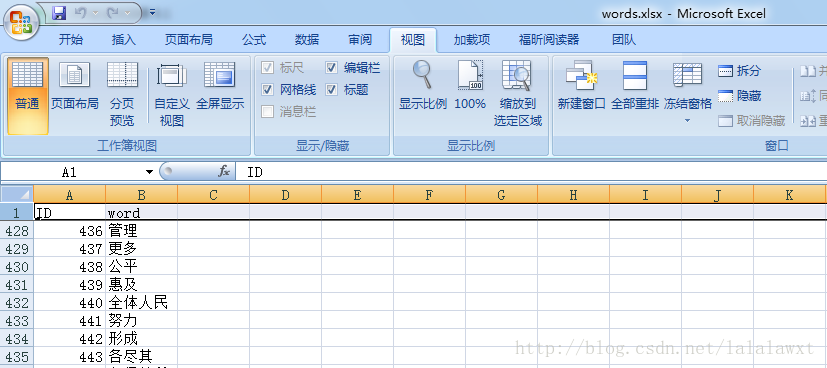逆向最大匹配方法
有正即有负,正向最大匹配算法大家可以参阅https://www.zzvips.com/article/123273.html
逆向最大匹配分词是中文分词基本算法之一,因为是机械切分,所以它也有分词速度快的优点,且逆向最大匹配分词比起正向最大匹配分词更符合人们的语言习惯。逆向最大匹配分词需要在已有词典的基础上,从被处理文档的末端开始匹配扫描,每次取最末端的i个字符(分词所确定的阈值i)作为匹配字段,若匹配失败,则去掉匹配字段最前面的一个字,继续匹配。而且选择的阈值越大,分词越慢,但准确性越好。
逆向最大匹配算法python实现:
分词文本示例:

分词词典words.xlsx示例:

|
1
2
3
4
5
6
7
8
9
10
11
12
13
14
15
16
17
18
19
20
21
22
23
24
25
26
27
28
29
30
31
32
33
34
35
36
37
38
39
40
41
42
43
44
45
46
47
48
49
50
51
52
53
54
55
56
57
58
59
60
61
62
63
64
65
66
67
68
69
70
71
72
73
|
#!/usr/bin/env python #-*- coding:utf-8 -*- ''''' 用逆向最大匹配法分词,不去除停用词 '''import codecs import xlrd #读取待分词文本,readlines()返回句子list def readfile(raw_file_path): with codecs.open(raw_file_path,"r",encoding="ANSI") as f: raw_file=f.readlines() return raw_file #读取分词词典,返回分词词典list def read_dic(dic_path): excel = xlrd.open_workbook(dic_path) sheet = excel.sheets()[0] # 读取第二列的数据 data_list = list(sheet.col_values(1))[1:] return data_list #逆向最大匹配法分词 def cut_words(raw_sentences,word_dic): word_cut=[] #最大词长,分词词典中的最大词长,为初始分词的最大词长 max_length=max(len(word) for word in word_dic) for sentence in raw_sentences: #strip()函数返回一个没有首尾空白字符(‘\n'、‘\r'、‘\t'、‘')的sentence,避免分词错误 sentence=sentence.strip() #单句中的字数 words_length = len(sentence) #存储切分出的词语 cut_word_list=[] #判断句子是否切分完毕 while words_length > 0: max_cut_length = min(words_length, max_length) for i in range(max_cut_length, 0, -1): #根据切片性质,截取words_length-i到words_length-1索引的字,不包括words_length,所以不会溢出 new_word = sentence[words_length - i: words_length] if new_word in word_dic: cut_word_list.append(new_word) words_length = words_length - i break elif i == 1: cut_word_list.append(new_word) words_length = words_length - 1 #因为是逆向最大匹配,所以最终需要把结果逆向输出,转换为原始顺序 cut_word_list.reverse() words="/".join(cut_word_list) #最终把句子首端的分词符号删除,是避免以后将分词结果转化为列表时会出现空字符串元素 word_cut.append(words.lstrip("/")) return word_cut #输出分词文本 def outfile(out_path,sentences): #输出模式是“a”即在原始文本上继续追加文本 with codecs.open(out_path,"a","utf8") as f: for sentence in sentences: f.write(sentence) print("well done!") def main(): #读取待分词文本 rawfile_path = r"逆向分词文本.txt" raw_file=readfile(rawfile_path) #读取分词词典 wordfile_path = r"words.xlsx" words_dic = read_dic(wordfile_path) #逆向最大匹配法分词 content_cut = cut_words(raw_file,words_dic) #输出文本 outfile_path = r"分词结果.txt" outfile(outfile_path,content_cut) if __name__=="__main__": main() |

总结
分析分词结果可以知道,机械分词的效果优劣,一方面与分词匹配算法有关,另外一方面极其依赖分词词典。所以若想得到好的分词效果,处理相关领域的文本时,需要在分词词典中加入特定领域的词汇。
以上就是本文关于python实现机械分词之逆向最大匹配算法代码示例的全部内容,希望对大家有所帮助。感兴趣的朋友可以继续参阅本站其他相关专题,如有不足之处,欢迎留言指出。感谢朋友们对本站的支持!
原文链接:http://blog.csdn.net/lalalawxt/article/details/75477931













